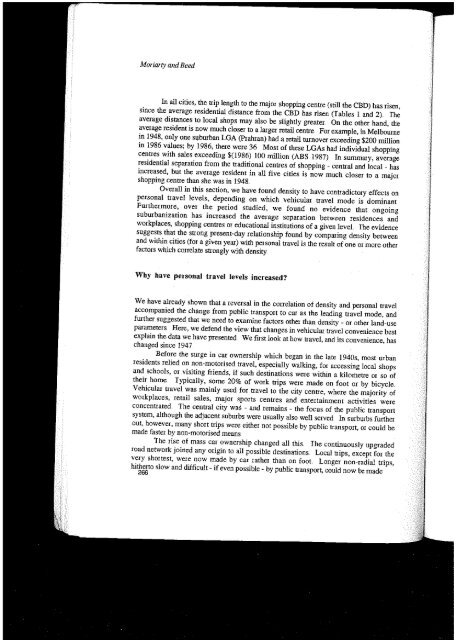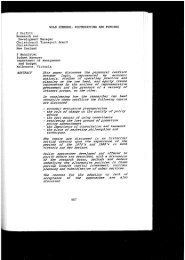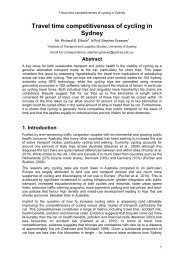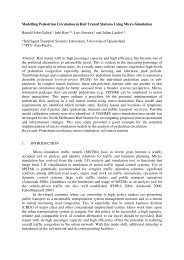PDF: 529 KB - ATRF.info
PDF: 529 KB - ATRF.info
PDF: 529 KB - ATRF.info
Create successful ePaper yourself
Turn your PDF publications into a flip-book with our unique Google optimized e-Paper software.
Moriarty andReed<br />
In all cities, the trip length to the major shopping centre (still the CBD) has risen,<br />
since the average residential distance from the CBD has risen (Tables I and 2). The<br />
average distances to local shops may also be slightly greater On the other hand, the<br />
average resident is now much closer to a larger retail centre, For example, in MelboUIne<br />
in 1948, only one sijburban LOA (PraInan) had a retail turnover exceeding $200 million<br />
in 1986 values; by 1986, there were 36 Most of these LOAs had individual shopping<br />
centres with sales exceeding $(1986) 100 million (ABS 1987) In summary, average<br />
residential separation from the traditional centres of shopping - central and local _ has<br />
increased, but the average resident in all five cities is now much closer to a major<br />
shopping centre than she was in 1948<br />
Overall in this section, we have found density to have contradictory effects on<br />
personal travel levels, depending on which vehicular travel mode is dominant<br />
FurtherffiOIe. over the period studied, we found no evidence that ongoing<br />
subwbanization has increased the average separation between residences and<br />
workplaces, shopping centres or educational institutions ofa given level The evidence<br />
suggests that the strong present-day relationship found by comparing density betweeu<br />
and within cities (for a given year) with personal travel is the result of one or more other<br />
factors which correlate strongly with density<br />
Why have personal travel levels increased?<br />
We have already shown that a reversal in the correlation of density and personal travel<br />
accompanied the change from public transport to car as the leading travel mode, and<br />
further suggested that we need to examine factors other than density - or other land-use<br />
parameters, Here, we defend the view that changes in vehicular travel convenience best<br />
explain the data we have presented. We fIrst look at how travel, and its convenience, has<br />
changed since 1947<br />
Before the surge in car ownership which began in the late I940s, most urban<br />
residents relied on non-motorised travel, especially walking, for accessing local shops<br />
and schools, or visiting friends, if such destinations were within a kilometre or so of<br />
their home Typically, some 20% of work trips were made on foot or by bicycle..<br />
Vehicular travel was mainly used for travel to the city centre, where the majority of<br />
workplaces. retail sales, major sports centres and entertainment activities were<br />
concentrated, The central city was - and remains - the focus of the public transport<br />
system, although the adjacent suburbs were usually also well served. In surburbs further<br />
out, however, many short trips were either not possible by public transport, or could be<br />
made faster by non-motorised means<br />
The rise of mass car ownership changed all this. The continuously upgraded<br />
road network joined any origin to all possible destinations.. Local trips, except for the<br />
very shortest, were now made by car rather than on foo!" Longer non-radial trips,<br />
hitherto slow and difficult - ifeven possible - by public transport, could now be made<br />
266





